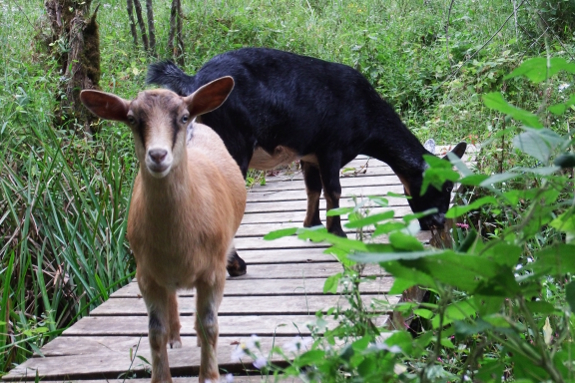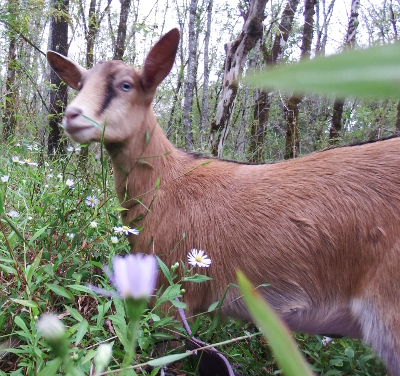
Which doe to breed?

I'd been planning on
breeding Artemesia again this fall because conventional wisdom has it
that the very earliest a doeling should be bred is 7 months and that
even that is dicey. However, conventional wisdom also has it that you
can breed a doeling when she's attained 70% of her adult weight. A
session with the weight
tape this week
turned up the information that Aurora is already 77% as heavy as her
mother and is, in fact, the weight Artemesia was at her first birthday.
 Now, some of that weight is fat.
I've been lax on chasing Aurora away from her mother's dinner and those
concentrates, combined with browse and lots of milk, mean our baby is
pretty darn chubby.
Now, some of that weight is fat.
I've been lax on chasing Aurora away from her mother's dinner and those
concentrates, combined with browse and lots of milk, mean our baby is
pretty darn chubby.
Still, I'm starting to
think maybe we should put her growth spurt to good use. If we breed
Aurora this fall, then Artemesia can gain back her milking weight at
her leisure and take a year off while Aurora loses some of her excess
weight the natural way.
I'd be curious to
hear from experienced goatkeepers. Would you breed a big, fat goatling
at her earliest possible breeding date or hold her over to the next
year for safety?
Want more in-depth information? Browse through our books.
Or explore more posts by date or by subject.
About us: Anna Hess and Mark Hamilton spent over a decade living self-sufficiently in the mountains of Virginia before moving north to start over from scratch in the foothills of Ohio. They've experimented with permaculture, no-till gardening, trailersteading, home-based microbusinesses and much more, writing about their adventures in both blogs and books.
Want to be notified when new comments are posted on this page? Click on the RSS button after you add a comment to subscribe to the comment feed, or simply check the box beside "email replies to me" while writing your comment.

Hey,
I worked on a goat dairy handling these sorts of questions for a long time, and I'd caution against breeding Aurora. While she's got some good weight on her, and a touch of chubbiness on a baby's not a bad thing to see, a heavier goat can have trouble getting pregnant -and if they do stay pregnant, that excess weight can trigger ketosis. I also like to see goats get to their full height before they're bred, if you can let them wait, because pregnancy will put a lot of stress on the spine and you'll wind up with problems down the road. You also get very, very low milk output from does bred this young- think less than half of what a yearling off her first freshening would produce.
You've dried Artemesia off, and she looks like she's probably in decent weight- dairy goats always look skinny, but she's got some good flesh on her hips and shoulders. You can always do some stuff to help her gain back even more (though again, make sure you don't overdo it, as that can lead to other problems). What sort of worm control measures do you take? Barberpole worms are worst when it's mild and wet out, so most of spring and fall. If she needs deworming, go for it. You can also see about making sure she's getting all her grain- you can put Aurora on a less-dense grain so she's got something to keep her busy while her mom's eating. Also, separating mom and daughter for part of the day, to help with weaning, so those extra calories aren't going straight into milk.
Good luck! Goats are a fun challenge.
well this is just my pennies worth. in my opinion is definitely breed her. I'm curious as to why you're not breeding both of them. but if she's healthy and in good shape there's absolutely no reason not to breed her. I've been dealing with my goats now for going on 6 years and I've always breed my young girls before they were a year. I have never had any problems and as for milk production there are so many factors that go into that that you can't definitively say that there would be less milk because the doe is Young. I keep a buck with my herd year round So doe's are normally bred at 5-6 months. They will have their pregnancy growth spurt and after that they continue growing until they're about two years old or so and I have never had problems.